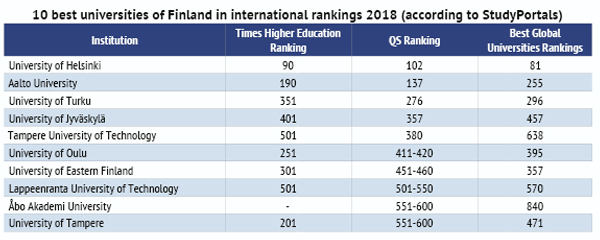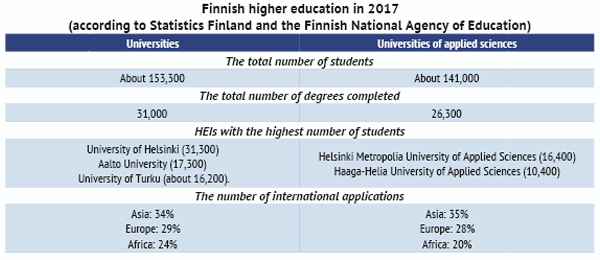The main principles of Finnish higher education policy

Finland is a Nordic welfare state that has successfully advanced into a world-class knowledge society which is proved by different international rankings. The main pillars of the Finnish education policy are quality, efficiency, equity and internationalization. It is based on the principles of lifelong learning and free education. Education is seen as a key to competitiveness and wellbeing of the egalitarian society. The higher education policy is planned and implemented by the Ministry of Education and Culture.
Finnish universities: two sectors, different approaches
The higher education system of Finland has a dual structure. It is divided into two complementary sectors having their own profiles. There are 14 universities that conduct fundamental research and offer undergraduate and postgraduate education (only universities can confer doctoral degrees) and 23 universities of applied sciences (UAS) that focus on professional higher education and are involved in research and development activities adopting a more practical approach. UAS have only eight fields of study (Business and Administration; Culture; Health Care and Social Services; Natural Resources; Seafaring; Sports; Technology; Tourism and Catering), while universities cover all academic disciplines. Finnish HEIs offer more than 400 English-taught academic programs ranging from short courses to full degrees.
Universities of Finland are independent corporations under public law or foundations under private law. They are responsible for the evaluation of their own operations and outcomes, with the assistance of FINEEC (the Finnish Education Evaluation Center). Universities are funded by the Government but they are also expected to raise external funding. The state resources for UAS are allocated in the form of core funding based on unit costs per student, project funding and performance-based funding [1].
Finnish higher education institutions attach the utmost importance to quality research and innovation. A higher education degree is considered a necessary step for establishing a solid foundation for a future career. Thanks to their basic education and broad selection criteria including national entrance exams and international test scores, Finnish students are highly motivated to study. Unlike in most countries, they also have a real influence on the quality of education, which is permitted by Finnish legislation [2].

Equality as a key principle
One of the basic principles of Finnish education is an equal access to high-quality education and training at all levels. The country places a strong emphasis on providing equal educational opportunities for all citizens developing the wide institutional network and providing free education, student financial aid and flexible pathways to higher education. In Finland there is a well-developed system of study grants and loans. Financial aid can be awarded for full-time study at Finnish HEIs. Universities do their best to maximize each studentʼs potential though educational guidance and counseling. Great efforts are made to support students with special needs, language minorities, and migrants.
To make higher education more accessible by lowering the application threshold, the Finnish universities offer an online joint application system. Prospective students can apply simultaneously for four different Bachelorʼs degree programs at Finnish UAS using the same joint application form with a strict order of preference of the study options. If they are not admitted to the option of their first preference, their points will be checked to see, if they can be admitted to the option of their second, third or fourth preference.
The equal opportunity principle is also followed regarding international students who have obtained their degrees at Finnish universities.
It is reflected in postgraduation equality in the job market. Universities can do a lot to avoid discrimination in recruitment, offering foreign students better opportunities to study Finnish and teaching them specialization-related technical terminology [3].
Internationalization: aims and tools
Internationalization has long been a major focus of the Finnish science and higher education policy. International collaboration and mobility in the Finnish society has been promoted by the Center for International Mobility and Cooperation (CIMO) established in 1991.
In 2009 a significant university reform process started in Finland. It involved setting the national strategy for the internationalization of higher education institutions for 2009-2015. Five primary aims for internationalization were as follows: (i) a genuinely international higher education community; (ii) increasing the quality and attractiveness of higher education institutions; (iii) promoting the export of expertise; (iv) supporting a multicultural society; (v) promoting global responsibility [4].
The Ministry of Education and Culture in Finland established a goal to increase the number of international students to 20,000 by the year of 2015. It did not take long for the strategy to start bearing fruit as by 2012 the number of foreign degree students in Finnish universities had more than doubled since 2003 (from about 8,000 to over 19,000).
In 2017 a steering group at the Ministry of Education and Culture developed a new international higher education and research policy for 2017-2025 [5]. The long-term goal of this strategy is to make Finland more open and international, rich in languages and cultures by 2025. The main objectives of this new strategy are:
- to familiarize all students getting a higher education degree with international, multicultural operating environments and to help them understand diversity, global challenges and principles of a sustainable society;
- to promote a smoother integration of foreign students, researchers and other staff into a truly international education and research Finnish community;
- to remove any obstacles to education exports taking into account the challenges related to versatility of foreign languages and cultures and impact of the introduction of tuition fees;
- to have Finnish HEIs set clear goals for their international activities and select actions to achieve these goals;
- to develop HEIsʼ joint measures in international cooperation.

Nowadays, five Finnish universities are aiming to recruit extra 150,000 international students by 2020. For example, Lappeenranta University of Technology hopes to double the number of foreign students from outside Europe, with a particular focus on China and India. They use an advanced platform developed by Edunation, an innovative start-up engaged in education export, which makes high-quality Finnish higher education much more easily available to the world. It aims to help international students with their application process and answer all questions they might have about living and studying in Finland. Through the Edunation platform they can enroll in full degree programs, participate in summer schools and exchange programs provided by Finnish HEIs.

To enhance international cooperation in the field of higher education and research and to promote the export of Finnish knowledge, expertise and educational innovation, the Ministry of Education and Culture is establishing a Team Finland Knowledge network that will start its work in autumn 2018 [6]. It will operate in China, Singapore, North America, Spanish-speaking South America, Sub-Saharan Africa, India, Russia, and later on, in the Persian Gulf region. Seven experts in science and education are supposed to be hired for different regions. In the first stage, experts will be placed in the Finnish embassies in Beijing, Singapore, Washington, and Buenos Aires. In autumn 2019, the network will be extended to Pretoria, New Delhi, Moscow, and the Persian Gulf region.
Thus, Finland strives to effectively implement its ambitious plans to be an active participant in the global community and to build the worldʼs best education and research environments by deepening its international connections. That is why Finnish HEIs fully adhere to the main principles of their higher education policy such as quality, efficiency, equity and internationalization.
REFERENCES
1. Finnish education in a nutshell. [Online] Available URL: http://www.oph.fi/download/146428_Finnish_Education_in_a_Nutshell.pdf [Accessed May 21, 2018]
2. StudyPortals. Bachelors. Study in Finland. [Online] Available URL: https://www.bachelorsportal.com/countries/9/finland.html [Accessed May 22, 2018]
3. Equal opportunities at university are reflected in equality in the job market. [Online] Available URL: https://syl.fi/en/blogi/equal-opportunities-at-university-are-reflected-in-equality-in-the-job-market/ [Accessed May 22, 2018]
4. Strategy for the Internationalization of Higher Education Institutions in Finland 2009–2015 [Online] Available URL: http://planipolis.iiep.unesco.org/sites/planipolis/files/ressources/finland_higher_education_strategy.pdf [Accessed May 21, 2018]
5. Better together for a better world [Online] Available URL: http://minedu.fi/documents/1410845/4154572/YMP-en-net.pdf/ab74d6b2-a48f-49ee-9563-6313f87198ae/YMP-en-net.pdf.pdf [Accessed May 21, 2018]
6. Team Finland Knowledge network to enhance the visibility of Finnish knowledge and expertise and to boost exports [Online] Available URL: http://valtioneuvosto.fi/en/artikkeli/-/asset_publisher/1410845/team-finland-knowledge-verkosto-lisaamaan-suomalaisen-osaamisen-nakyvyytta-ja-vauhdittamaan-vientia [Accessed May 22, 2018]